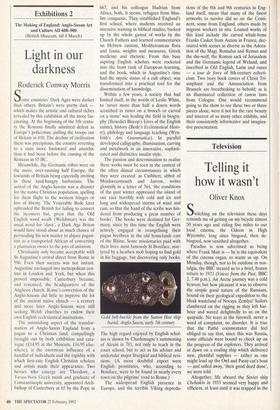Exhibitions 2
The Making of England: Anglo-Saxon Art and Culture AD 600-900 (British Museum, till 8 March)
Light in our darkness
Roderick Conway Morris
Sums countries' Dark Ages were darker than others. Britain's were pretty dark which makes the artistic and cultural riches revealed by this exhibition all the more fas- cinating. At the beginning of the 5th centu- ry the Romans finally admitted defeat as Europe's policeman, pulling the troops out of Britain in 410. The decline of civilisation there was precipitous, the country reverting to a state more backward and anarchic than it had been before the coming of the Romans in 55 BC.
Meanwhile, the Germanic tribes were on the move, over-running half Europe, the lowlands of Britain being especially inviting to these land-hungry barbarians. The arrival of the Anglo-Saxons was a disaster for the native Christian population, spelling for them flight to the western fringes or loss of liberty. The Venerable Bede later upbraided the British for failing to convert the incomers but, given that the Old English word wealh (Welshmar ) was the usual word for 'slave', a Dark Age Briton would have stood about as much chance of persuading his new master to abjure pagan- ism as a transported African of converting a plantation owner to the joys of animism.
Christianity only became acceptable with St Augustine's arrival direct from Rome in 596. Even then success was not instant. Augustine envisaged two metropolitan cen- tres in London and York, but when this proved impossible, Canterbury became, and remained, the headquarters of the Anglican church. Rome's conversion of the Anglo-Saxons did little to improve the lot of the ancient native church — a century and more later Anglo-Saxons were still sacking Welsh churches to endow their own English ecclesiastical institutions.
The astonishing aspect of the transfor- mation of Anglo-Saxon England from a pagan to a Christian land, compellingly brought out by both exhibition and cata- logue (£14.95 at the Museum, £16.95 else- where), is the enormous influence of a handful of individuals and the rapidity with which first-rate English Christian scholars and artists made their appearance. Two heroes who emerge are Theodore, a Tarsus-born Greek monk and graduate of Constantinople university, appointed Arch- bishop of Canterbury at 65 by the Pope in
667, and his colleague Hadrian from Africa, both, it seems, refugees from Mus- lim conquests. They established England's first school, where students received an intensive training in biblical studies, backed up by the whole gamut of works by the Church Fathers and learned commentaries on Hebrew custom, Mediterranean flora and fauna, weights and measures, Greek medicine and rhetoric. From this base aspiring English scholars were rocketed into the front rank of European learning, and the book, which in Augustine's time had the mystic status of a cult object, was transformed into a practical tool for the dissemination of knowledge.
Within a few years, a society that had limited itself, in the words of Leslie White, to 'never more than half a dozen words scratched in runes on a brooch or carved on a stone' was leading the field in biogra- phy (Benedict Biscop's Lives of the English saints), history (Bede's Ecclesiastical Histo- ry), philology and language teaching (Wyn- frith's Arts Grammatica). In parallel developed calligraphy, illumination, carving and metalwork in an innovative, sophisti- cated and distinctive insular style.
The passion and determination to realise these works must be seen in the context of the often dismal circumstances in which they were created: as Cuthbert, abbot of Monkwearmouth and Jarrow, writes gloomily in a letter of 764, 'the conditions of the past winter oppressed the island of our race horribly with cold and ice and long and widespread storms of wind and rain, so that the hand of the scribe was hin- dered from producing a great number of books'. The books were destined for Ger- many, since by this time the English were actively engaged in evangelising their pagan brethren in the old homelands east of the Rhine. Some missionaries paid with their lives: most famously St Boniface, mar- tyred by a heathen mob hoping to find gold in his baggage, but discovering only books.
Gold belt-buckle from the Sutton Hoo ship burial, Anglo-Saxon, early 7th century The high regard enjoyed by English schol- ars is shown by Charlemagne's summoning of Alcuin in 781, not only to teach in the court school, but to act as his adviser and undertake major liturgical and biblical revi- sions. (A more doubtful export were English prostitutes, who, according to Boniface, were to be found in nearly every town on the pilgrims' road to Rome.)
The widespread English presence in Europe, and the terrible Viking depreda- tions of the 8th and 9th centuries in Eng- land itself, mean that many of the finest artworks to survive did so on the Conti- nent, some from England, others made by migrant workers in situ. Loaned works of this kind include the carved whale-bone Franks Casket from Auzon in France, dec- orated with scenes as diverse as the Adora- tion of the Magi, Romulus and Remus and the she-wolf, the Roman sack of Jerusalem and the Germanic legend of Weland, and inscribed in Old English, Latin and runes — a tour de force of 8th-century eclecti- cism. Two ivory book covers of Christ Tri- umphant and the Annunciation from Brussels are breathtaking to behold; as is an illuminated collection of canon laws from Cologne. One would recommend going to the show to see these two or three pieces alone, were it not for the rare beauty and interest of so many other exhibits, and their consistently informative and imagina- tive presentation.


















































 Previous page
Previous page